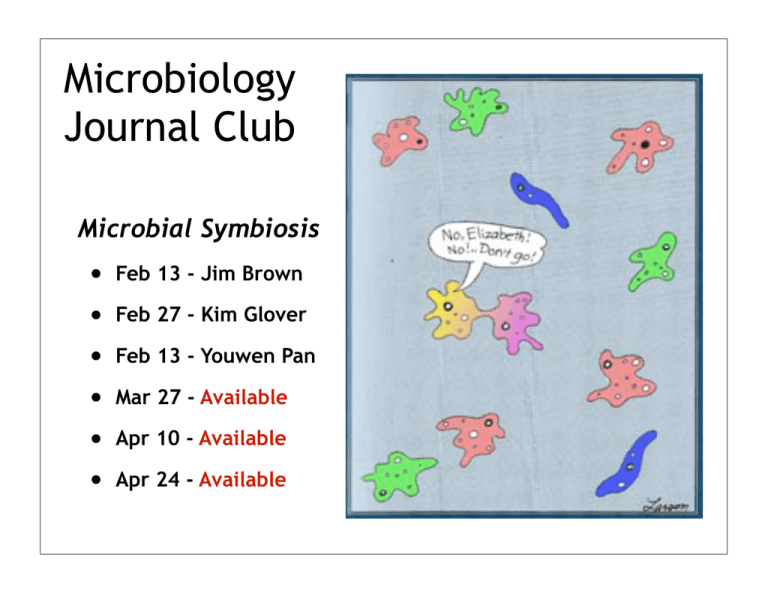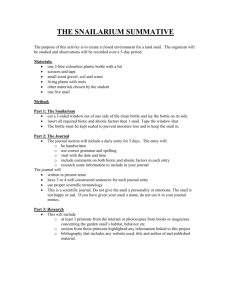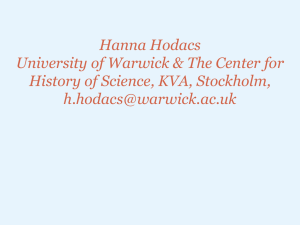
Microbiology
Journal Club
Microbial Symbiosis
•
•
•
•
•
•
Feb 13 - Jim Brown
Feb 27 - Kim Glover
Feb 13 - Youwen Pan
Mar 27 - Available
Apr 10 - Available
Apr 24 - Available
APPLIED AND ENVIRONMENTAL MICROBIOLOGY, May 2004, p. 3082–3090
0099-2240/04/$08.00!0 DOI: 10.1128/AEM.70.5.3082–3090.2004
Copyright © 2004, American Society for Microbiology. All Rights Reserved.
Vol. 70, No. 5
Novel Forms of Structural Integration between Microbes and a
Hydrothermal Vent Gastropod from the Indian Ocean
Shana K. Goffredi,1* Anders Warén,2 Victoria J. Orphan,3 Cindy L. Van Dover,4
and Robert C. Vrijenhoek1
Monterey Bay Aquarium Research Institute, Moss Landing, California 950391; Swedish Museum of Natural History,
SE-10405 Stockholm, Sweden2; NASA Ames Research Center, Moffet Field, California 940353; and Biology
Department, College of William & Mary, Williamsburg, Virginia 231874
Received 30 September 2003/Accepted 2 February 2004
Here we describe novel forms of structural integration between endo- and episymbiotic microbes and an
unusual new species of snail from hydrothermal vents in the Indian Ocean. The snail houses a dense
population of !-proteobacteria within the cells of its greatly enlarged esophageal gland. This tissue setting
differs from that of all other vent mollusks, which harbor sulfur-oxidizing endosymbionts in their gills. The
significantly reduced digestive tract, the isotopic signatures of the snail tissues, and the presence of internal
bacteria suggest a dependence on chemoautotrophy for nutrition. Most notably, this snail is unique in having
a dense coat of mineralized scales covering the sides of its foot, a feature seen in no other living metazoan. The
scales are coated with iron sulfides (pyrite and greigite) and heavily colonized by "- and #-proteobacteria, likely
participating in mineralization of the sclerites. This novel metazoan-microbial collaboration illustrates the
great potential of organismal adaptation in chemically and physically challenging deep-sea environments.
Novel symbiotic relationships have contributed greatly to the
nutritional, physiological, behavioral, and anatomical diversification of multicellular organisms (11, 23). The discovery of
deep-sea hydrothermal vent ecosystems in 1977 exposed many
new animals that derive their nutrition from chemoautotrophic
vent sites are no exception, with high abundances of bresiliid
shrimp, provannid snails, and bathymodiolin mussels, all
shown to have either endo- or epibionts (14, 35, 39, 44). Until
recently, gastropod mollusks were known to primarily dominate western Pacific vent sites. Hydrothermal vents on the
Calyptogena
Bathymodiolus
Provannidae
Rimicaris
Alvinella
Alvinoconcha
Riftia
The scaly snail has no operculum!
A chemoautotrophic snail?
•
•
•
•
•
Highly reduced digestive tract (containing only iron sulfides)
Weak radula
Well-developed circulatory system
Large, well-developed gills (but no symbionts)
HUGE esophageal glands! Well-developed network of blood
vessels between foot & esophageal glands
Bacteriocytes
. 70, 2004
METAZOAN INT
OL.
70, 2004
METAZOAN INTEGRATION WITH MULTIPLE MICROBIAL GROUPS
Bacteria
FeS
Conchiolin
FeS
3086
GOFFREDI ET AL.
APPL. ENVIRON. MICROBIOL.
FIG. 4. Phylogenetic relationships, based on partial 16S rDNA gene
sequences (958 bp), of the scaly snail endosymbiont (bold with arrow)
and epibionts (bold) within the three major proteobacterial subdivisions
(101 taxa included). Numbers in parenthesess following boldfaced taxa
indicate the number of clones represented by each particular ribotype on
the scales (first number) and the shell (second number). A neighborjoining tree with Kimura two-parameter distances is shown. The numbers
at the nodes represent bootstrap values from both neighbor-joining (first
value) and parsimony (second value) methods obtained from 1,000 and 100
replicate samplings, respectively. In addition to microbes associated
with the scaly snail, sequences were obtained from GenBank as noted.
thiotrophic
epsilon
proteobacteria
thiotrophic
gamma
proteobacteria
sulfate-reducing
delta
proteobacteria
FIG. 4. Phylogenetic relationships, based on partial 16S rDNA gene sequences (!958 bp), of the scaly snail endosymbiont (bold with arrow)
and epibionts (bold) within the three major proteobacterial subdivisions (101 taxa included). Numbers in parenthesess following boldfaced taxa
indicate the number of clones represented by each particular ribotype on the scales (first number) and the shell (second number). A neighborjoining tree with Kimura two-parameter distances is shown. The numbers at the nodes represent bootstrap values from both neighbor-joining (first
value) and parsimony (second value) methods obtained from 1,000 and 100 replicate samplings, respectively. In addition to microbes associated
free-living vent thiotroph
Riftia symbiont
ogenetic relationships, based on partial 16S rDNA gene sequences (!958 bp), of the scaly snail endosymbiont (bold with arrow)
bold) within the three major proteobacterial subdivisions (101 taxa included). Numbers in parenthesess following boldfaced taxa
VOL. 70, 2004
METAZOAN INTEGRATION WITH MULTIPLE MICROBIAL GROUPS
3087
FIG. 5. Phylogenetic relationships,
based on partial 16S rDNA gene
sequences (1,236 bp), of the scaly snail
epibionts (in bold) within the
Cytophaga-Flavobacterium-Bacteroides
(CFB) and green nonsulfur (GNS)
microbial groups (28 taxa included).
Numbers in parentheses following
boldfaced taxa indicate the number of
clones represented by each particular
ribotype on the scales (first number)
and the shell (second number). A
neighbor-joining tree with Kimura twoparameter distances is shown. The
numbers at the nodes represent
bootstrap values from both neighborjoining (first value) and parsimony
(second value) methods obtained from
1,000 replicate samplings. The
GenBank accession numbers for
sequences acquired during this study
are listed in the text. In addition to
microbes associated with the scaly
snail, sequences were obtained from
GenBank as noted.
FIG. 5. Phylogenetic relationships, based on partial 16S rDNA gene sequences (1,236 bp), of the scaly snail epibionts (in bold) within the
Cytophaga-Flavobacterium-Bacteroides (CFB) and green nonsulfur (GNS) microbial groups (28 taxa included). Numbers in parentheses following
boldfaced taxa indicate the number of clones represented by each particular ribotype on the scales (first number) and the shell (second number). A
neighbor-joining tree with Kimura two-parameter distances is shown. The numbers at the nodes represent bootstrap values from both neighbor-joining
(first value) and parsimony (second value) methods obtained from 1,000 replicate samplings. The GenBank accession numbers for sequences acquired
during this study are listed in the text. In addition to microbes associated with the scaly snail, sequences were obtained from GenBank as noted.
3088
GOFFREDI ET AL.
APPL. ENVIRON. MICROBIOL.
TABLE 1. Stable isotope compositions of Indian Ocean hydrothermal vent gastropods
Sample
Scaly snaila
Phymorhynchus spp. nov.b
Lepetodrilus sp. nov.
a
b
Avg ‰ # SD
Tissue
No. of samples
tested
!13C
!15N
Esophageal gland
Gill
Foot
Scales
Whole animal
Whole animal
4
4
4
4
3
9
$20.7 # 0.9
$18.3 # 0.6
$18.2 # 0.6
$16.7 # 0.6
$14.5 # 1.8
$14.0 # 1.0
3.3 # 1.8
3.9 # 0.6
3.8 # 0.5
3.8 # 0.9
8.8 # 0.6
6.8 # 0.8
Comparable whole-animal bulk measurements (!13C % $17.7 # 0.4‰, !15N % 3.1 # 0.5‰) were made by Van Dover et al. (44).
Identified by A. Waren.
bacteria involved in sulfur cycling (Fig. 4). The sclerite-associated microflora clustered mainly within !-proteobacteria found
in hydrothermal vents, sulfate-reducing lineages of the !-proteobacteria, and "-proteobacteria (distinct from the esophageal gland bacteria). Evidence suggests that the episymbiotic
bacteria of the scaly snail were not common on available surfaces or among gastropods within the same habitat. The microfloral composition of the scaly snail sclerites was different
from the microflora found on hydrothermal vent chimney sulfides (from the scaly snail habitat), which consisted mostly of
!-proteobacteria and Aquificales spp. (19). Similarly, scanning
electron microscopy observations suggested that the abundance of microflora observed on the shell of the scaly snail was
lower than that on the sclerites and comprised only a subset of
ribotypes of !- and !-proteobacteria. Additionally, PCR amplifications of bacterial sequences from the foot tissue of cooccurring gastropod species were negative.
•
ing clone libraries argue against their involvement in mineralization of the scaly snail sclerites.
The relationship between the microflora of the scaly snail
sclerites and the mineralized layer of iron sulfide and the
greater relative abundance of sulfate-reducing, iron sulfideproducing !-proteobacteria on the sclerites compared to other
surfaces lead us to infer that the fortification of the sclerites is
a result of the !-proteobacterial episymbiotic microflora. The
involvement of the snail is also likely, however, based on the
specialized internal structure of the scales, the presence of
mineralized particles within the snail conchiolin itself, the position of the microbes (i.e., fewer bacteria on the shell and
other external tissues of the scaly snail itself), and the lack of
microbes on the foot and opercular tissues of gastropods found
within the same environment. We hypothesize that the snail
facilitates the attachment of bacteria to the sclerites by the
secretion of organic compounds (i.e., mucus), and, in turn, the
Depletion in heavy isotopes relative to predatory
(Phymorhynchus) or grazing (Lepetodrilus) species implies a
“unique carbon and nitrogen source”, presumably
chemoautotrophic endosymbionts






